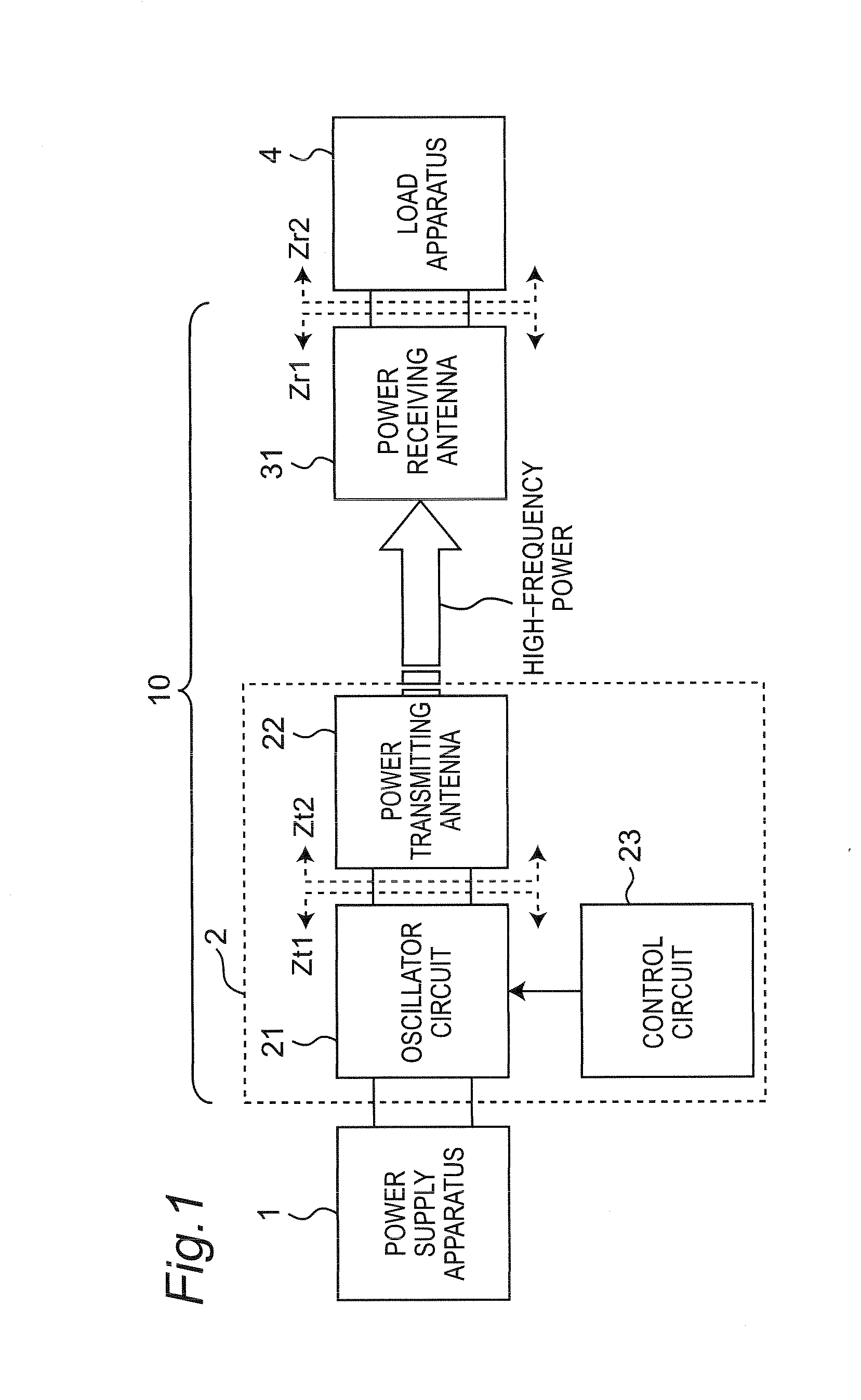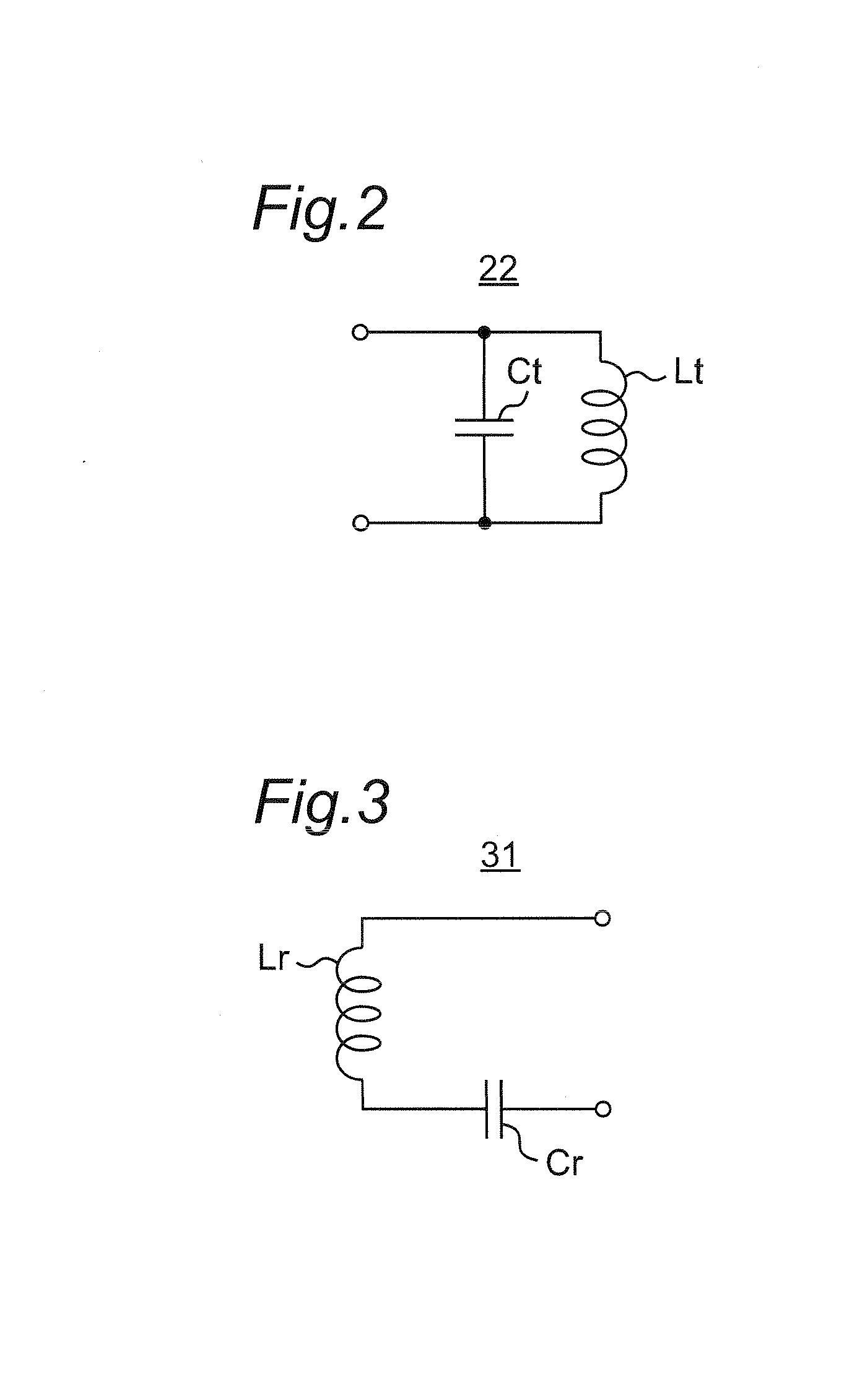Wireless power transmission system capable of continuing power transmission while suppressing heatup of foreign objects
a technology of power transmission system and foreign object, which is applied in the direction of charging stations, transportation and packaging, cycles, etc., can solve the problems of wireless power transmission system not being able to resume power transmission, foreign object heatup, etc., and achieve the effect of suppressing foreign object heatup
- Summary
- Abstract
- Description
- Claims
- Application Information
AI Technical Summary
Benefits of technology
Problems solved by technology
Method used
Image
Examples
first embodiment
[0088]FIG. 1 is a block diagram showing a configuration of a wireless power transmission system 10 according to a first embodiment. The wireless power transmission system 10 includes: a wireless power transmitting apparatus 2 connected to a power supply apparatus 1; and a power receiving antenna 31 connected to a load apparatus 4. The wireless power transmission system 10 wirelessly transmits high-frequency power from a power transmitting antenna 22 of the wireless power transmitting apparatus 2 to the power receiving antenna.
[0089]The power supply apparatus 1 converts alternating-current power from a commercial alternating-current power supply, into direct-current power, and outputs the direct-current power to the wireless power transmission system 10. Alternatively, the power supply apparatus 1 converts the voltage of direct-current power from a direct-current power supply such as a battery, and outputs the power to the wireless power transmitting apparatus 2. The wireless power t...
second embodiment
[0151]FIG. 24 is a block diagram showing a schematic configuration of a wireless power transmission system 10A according to a second embodiment. The wireless power transmission system 10A includes: a wireless power transmitting apparatus 2A connected to the power supply apparatus 1; and a wireless power receiving apparatus 3A connected to the load apparatus 4. The wireless power transmission system 10A wirelessly transmits high-frequency power from the wireless power transmitting apparatus 2A to the wireless power receiving apparatus 3A.
[0152]The wireless power transmitting apparatus 2A is provided with a power transmitting circuit 21A, the power transmitting antenna 22, a control circuit 23A, and the sensor 24. The power transmitting antenna 22 of the wireless power transmitting apparatus 2A is configured in a manner similar to that of the power transmitting antenna 22 of FIG. 2 or the power transmitting antenna 22a of FIG. 4. The power transmitting circuit 21A is connected to the ...
third embodiment
[0184]FIG. 38 is a block diagram showing a configuration of a wireless power transmission system 10B according to a third embodiment. The wireless power transmission system 10B includes: a wireless power transmitting apparatus 2B connected to the power supply apparatus 1; and a wireless power receiving apparatus 3B connected to the load apparatus 4. The wireless power transmission system 10B wirelessly transmits high-frequency power from the wireless power transmitting apparatus 2B to the wireless power receiving apparatus 3B.
[0185]Referring to FIG. 38, the wireless power transmitting apparatus 2B is provided with an oscillator circuit 21B, a power transmitting antenna 22B, and a control circuit 23B. The oscillator circuit 21B operates as a power transmitting circuit for generating high-frequency power from inputted direct-current power, and outputting the high-frequency power to the power transmitting antenna 22B. The oscillator circuit 21B is provided with: a pulse generator for g...
PUM
 Login to View More
Login to View More Abstract
Description
Claims
Application Information
 Login to View More
Login to View More - R&D
- Intellectual Property
- Life Sciences
- Materials
- Tech Scout
- Unparalleled Data Quality
- Higher Quality Content
- 60% Fewer Hallucinations
Browse by: Latest US Patents, China's latest patents, Technical Efficacy Thesaurus, Application Domain, Technology Topic, Popular Technical Reports.
© 2025 PatSnap. All rights reserved.Legal|Privacy policy|Modern Slavery Act Transparency Statement|Sitemap|About US| Contact US: help@patsnap.com



